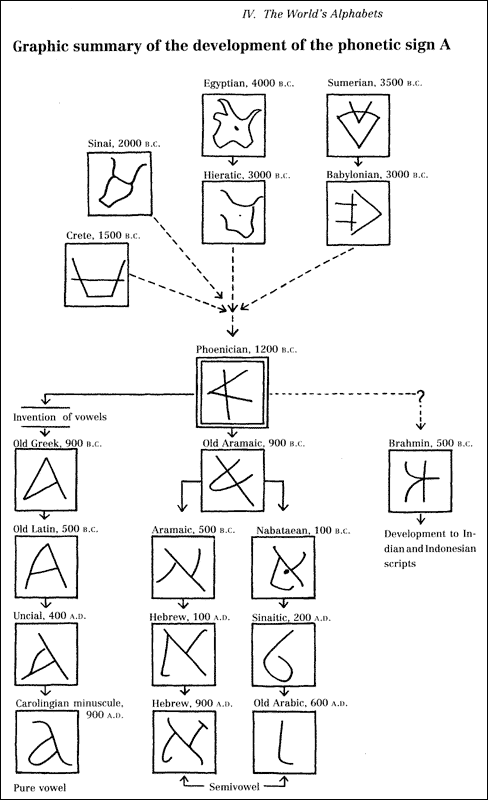
The Beginning
Most of us never really think about where those 26 letters, the alphabet, came from. Some of us might assume that those cave paintings, which have been around for 60,000 years, must have some connection. Surely, they must have been mans way of communicating his/her thoughts. In the true sense of being a precurser, they have no connection to what we call a present day script.
Man, back in the Ice Age, had many other issues to deal with, least of them being recording of speech. Markings on cave walls were done to appease the "gods".
The paintings were most likely produced from fear of the supernatural and for reasons of survival. A system of communication or kind of speech, which developed over millions of years, did include some sounds but was also made up of forms of expression.
This speech included all the senses, not just hearing. Original language consisted of sounds, gestures, facial expressions, touching, nasal noises. A question might be, "How much of what we call body language might have been part of the origin of written records?" How often have you had the need to scribble or sketch out an idea or explanation along with your verbal description? It seems to be an inner need for man to express ideas not only verbally but also in a figurative gesture.
Neolithic man became aware of their own limitations of time and space, life and death. They realized a need to not only express past experiences and future plans but to have record of these new perceptions. When we look at prehistoric drawings, we imagine that some kind of narrative must have accompanied them. The drawings have lasted but the speech and the meanings of the signs have not been handed down.
PICTOGRAPHS
A Pictograph [1] (also called pictogram or pictogramme) is an ideogram that conveys its meaning through its pictorial resemblance to a physical object. Earliest examples of pictographs include ancient or prehistoric drawings or paintings found on rock walls. Pictographs are also used in writing and graphic systems in which the characters are to considerable extent pictorial in appearance.
Pictography is a form of writing which uses representational, pictorial drawings. It is a basis of cuneiform and, to some extent, hieroglyphic writing, which uses drawings also as phonetic letters or determinative rhymes.
Early written symbols were based on pictographs (pictures which resemble what they signify) and ideograms (symbols which represent ideas). They were used by the ancient Chinese culture since around 5000 BC and began to develop into logographic writing systems around 2000 BC. Pictographs are still in use as the main medium of written communication in some non-literate cultures in Africa, The Americas, and Oceania. Pictographs are often used as simple, pictorial, representational symbols by most contemporary cultures.
Pictographs can often transcend languages in that they can communicate to speakers of a number of tongues and language families equally effectively, even if the languages and cultures are completely different. This is why road signs and similar pictographic material are often applied as global standards expected to be understood by nearly all.
Pictographs can also take the form of diagrams to represent statistical data by pictorial forms, and can be varied in color, size, or number to indicate change. Wikipedia
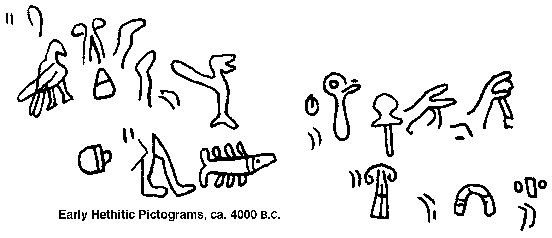
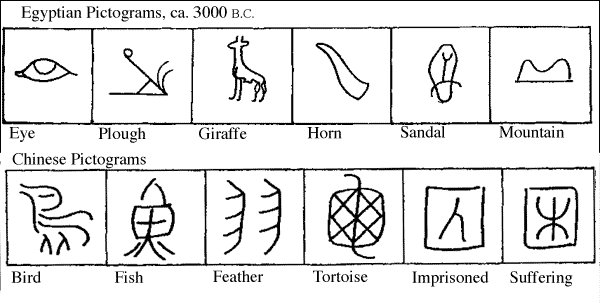
IDEOGRAPHS / Ideograms

The need to communicate abstract thoughts developed as man developed.
An ideogram or ideograph is a graphic symbol that represents an idea or concept. Some ideograms are comprehensible only by familiarity with prior convention; others convey their meaning through pictorial resemblance to a physical object, and thus may also be referred to as pictograms.
Examples of ideograms include wayfinding signs, such as in airports and other environments where many people may not be familiar with the language of the place they are in, as well as Arabic numerals and formal languages (mathematical notation, logic, UML), which are used worldwide regardless of how they are pronounced in different languages. Other examples include the Blissymbols, Emoticons and pictographs as used by the Sioux and Ojibwa.
Symbols began to take on broader meanings.
Ox, for example could now also mean food, not just a beast of burden.
A pictograph of mother and child could also mean happiness and not just mother.
Symbols no longer represented objects, but represented ideas, called ideograhs.
Can you think of a contemporary example of an ideograph?
Ideograms were simplified pictures selected by agreement or custom to become fixed pictorial symbols of an object or concept. For example, a number of "tree" symbols were unified to make a "forest," or the symbol for man, woman, and child were consolidated into a single "family" symbol. The name of the object (or its action) is closely identified with the picture. All written languages have passed through, or halted, at this stage.
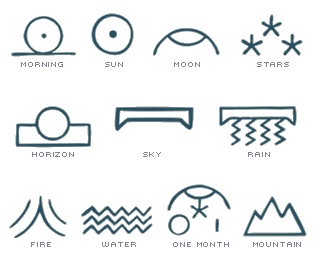
http://www.mediumbold.com/
Writing,
About 4,000 B.C., in the Middle East, drawings or signs appear in direct relationship with spoken syllables, words, or phrases.
This is the first appearance of "scribes,"however, did not develop until these pictograms were
arranged horizontally or vertically in rows to represent a linear train of thought or ideas.
Comparison of three major cultures using basic pictographic scripts.
Top row are Pictograms
Bottom row are Ideograms
Take the two pictographs and combining them to create an idea.
Chinese signs:
ear behind a door - listen or evesdrop
Mesopotamian cuneiforms:
mountains in the bull's head - wild (bull longs for the mountains)
Egyptian Hieroglyphics
Water and jug - fresh or cool
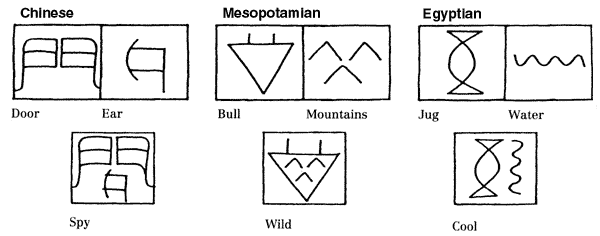
Below are Ideograms with abstract meanings.
• Chinese dot in the target means center
• Swastika of the four wind directions stands for region or land
Mesopotamian- the sign for sun means movement
•
Arrow means speed
Egyptian- figurative signs - plant leaning means south
• bird with it's head down means seek

Script Development
Pictorial signs were the origin of all scripts that have come into existence through a natural course of development.
Two categories of Script
1. Pictorial Scripts which have remained as pictures.
These scripts have undergone no revolutionary change over the centuries. They have been stylized but still are pictorial signs.
Chinese script is an example. It has kept the basic stroke and movements but has become stylized over the centuries. Calligraphic brush was invented in 200BC and is partly responsible for the smooth, sloping strokes, bowed lines; The architectural building style is also reflected in the Chinese script. The building style and calligraphy are an expression of the culture of the Far East and is reflected in their script.
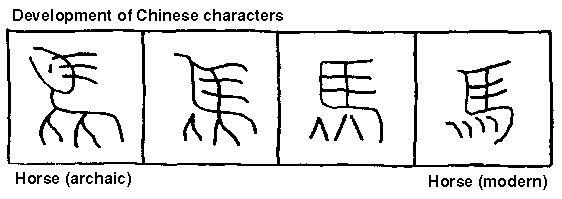
2. Alphabetical scripts is the second category.
Scripts where the original pictorial signs have been changed over the centuries to purely phonetic signs.
Strokes have been reduced to the most extreme simplification or abstraction.
Latin Alphabet is an example.
Egyptian Hieroglyphics
Egyptian people were fascinated by the power of nature, and rich in fantasy, they used "magical" signs to try and conjure up these powers of nature.
Hieroglyphic: Sacred Carvings
applies exclusively to pictograms which were created by the priests, guardians of religious and political tradition.
The Rosetta Stone
Refers to the crucial breakthrough in the research regarding Egyptian hieroglyphs. French scholar Jean Francois Champollion in 1822 deciphered the hieroglyphs to prove it was a spoken language used to communicate.
Common People
The cursive hieratic script, developed around 3000BC, used a reed on papyrus which simplified the hieroglyphic signs to flowing forms and strokes.
PHOENICIAN ALPHABET
In 1600 B.C. a nation of traders and merchants, the Phoenicians, need to keep business ledgers in a simplified writing form.A new concept in written communication evolved:
the use of symbols to represent sounds made in speaking rather than using symbols to represent ideas or objects.One of the primary spoken sounds was the "A" in the first syllable of the word aleph, meaning ox.Using this symbol they assigned the sound "A" to it rather than develop a new symbol.e was done for "B" which is found in beth meaning house.By using a different symbol for each of the recognizable spoken sounds, the Phoenicians developed the aleph.
With fewer symbols (22 Phoenician sound signs) than the older
picto-ideograph system, it was easier to learn and the simpler letterforms made writing easier.
GREEK ALPHABET
In 1000 B.C. the Greeks adopted the Phoenician alphabet. The Greeks viewed this alphabet as a means of preserving knowledge. They took the names of the Phoenician letters and made them Greek.
Aleph became alpha, beth became beta. From these two letters we derive the word alphabet. The Phoenician alphabet had no vowels, only consonants. To broaden the use of the alphabet, the Greeks added 5 vowels and formalized the letterforms. In 403 B.C., the revised alphabet was adopted by the Athenians.
ROMAN ALPHABET
The Romans adopted and modified the Greek alphabet.
Thirteen letters were accepted unchanged:
A, B, E, H, I, K, M, N, O, T, X, Y, Z.
Eight were revised:
C, G, D, L, P, R, S, V.
Two were added:
F, Q
These 23 letters were all that were need to write Latin.
U and W were added about 1,000 years ago, and J added just 500 years later.
The Romans also dropped the alpha and beta designations and used the simpler A, B, C.
First example of printing from "movable type" was discovered in 1908 by an Italian archaeologist on the island of Crete. He found a clay disc in the ruins of the palace of Phaistos in a stratification dated about 1500 B.C. Printing from movable type appeared in China and Korea in the 11th century.
(wood carvings)
1440 Johann Gutenberg brought the West up to date with his invention of movable type.
Until Gutenberg all books were laboriously hand written by scribes. Gutenberg
is given the credit for inventing the printing press because he had the
forsight to co-ordinate all the factors needed to create text on paper.
- supply individual letters cast in metal
- assembling and locking those letters to make words
- paper to receive the impressions
- ink to register the imprression
- way to bring the paper and ink together under pressure
Historians credit his invention as the beginning of printing, coinciding
- with the end of the Middle Ages and the
- beginning of Modern History.
Our common type faces are either imitations of early hand-written letters or represent a modification of early type faces which, in turn, were modeled after the lettering in manuscript books.
The standard roman lower-case letters and capitals assumed their present form about 1470 in a face cut by Nicholas Jenson. The letters inscribed in manuscript books by Venetian monks were Jenson's models.His types served as a pattern for later faces.
He is credited with the development of Roman type.
Images from Signs and Symbols: Their Design and Meaning
by Adrian Frutiger
